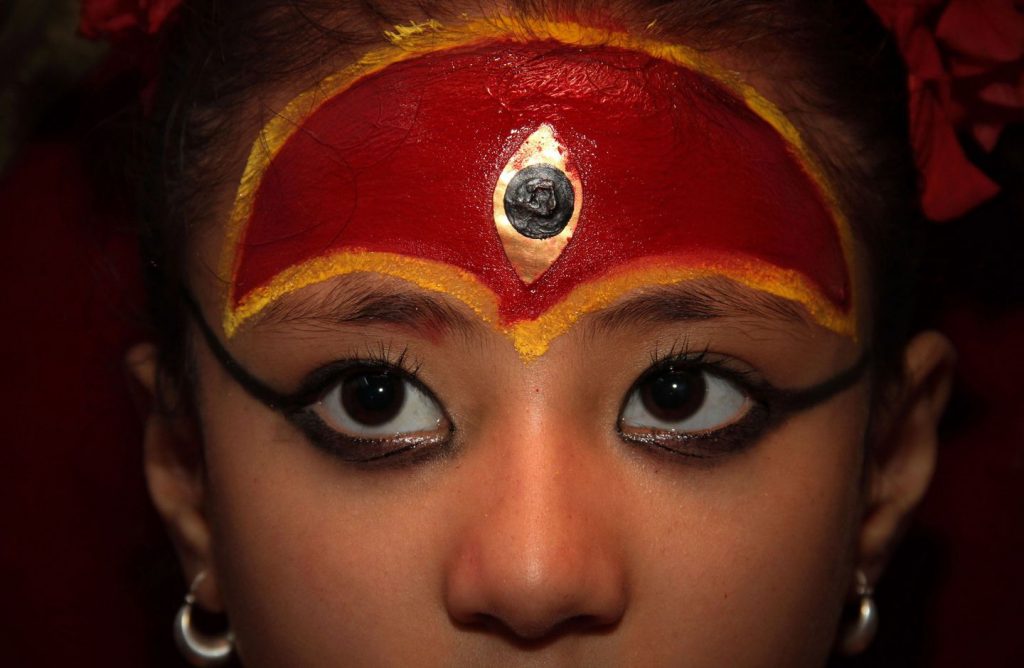Winner of the Fall 2017 StMU History Media Award for
Best Article in the Category of “Religion”
In most religious traditions, god and goddesses exist only in the spiritual realm, and are worshiped and revered in various forms, from statues and paintings to symbols and faith. But, the case is different when it comes to the religious tradition of Nepal. There a tradition has developed of worshiping a young pre-pubescent girl as the display of divine Devi, simply goddess. Sounds interesting, right? A virgin girl from the age of three or four until her puberty is worshiped as Kumari, the Living Goddess. Simply put, Kumari literally translates to “virgin.” This word has come down from the Sanskrit word Kumarya, which means princess.1 Furthermore, the word Kumari is used in the Mahabharata and other early Hindu texts as an epithet of Durga, the great warrior goddess who vanquished the demon Mahisasura.2

Kumari is accompanied by attraction and appreciation. The Living Goddess is the survivor of a tradition that dates back more than two thousand years. And Nepal is probably the last place on earth where the supreme god is considered as a woman, where the god is a young girl. Before taking about the origin of the tradition, it’s worth explaining who this child is in the present day and where she comes from. Uniquely, the Kumari is worshiped by both Hindus—as the goddess Taleju—and by Buddhists—as the embodiment of the goddess Vajra Devi.3 The child herself is Buddhist, from the high-religious caste of Shakyas, goldsmiths of the Newar-community of Nepal. Kumari is dressed in red, because red is considered the color of gods and power among Hindus in Nepal. The Kumari wears a bright red jama (cloak) down to her feet, a red bhoto (shirt), and a red pagari (turban). She has a ‘tri-netra’ (third eye) painted on her forehead. The eye is metaphorical, and it is believed to destroy all the evil in the world.4 She also wears a bejeweled crown and is bedecked with gold snake necklaces and sacred amulets, and she gazes at the world enigmatically, never smiling. If she smiles at you—worshippers believe—it is an invitation to heaven, and you die.5
The Kumari’s red tika, which is placed on her forehead (above the third eye) artistically during festivals, is called bhrigu. It represents the cosmic energy of the earth. This brightest and most glowing tika is a sign of wealth, prosperity, and a bright future for the nation. The special tika is prepared by mixing vermilion powder, rock crystal powder, a kind of sweet scented natural powder called ‘kumkum,’ and sesame seed oil.6
The origin and development of this tradition is deeply rooted in Hindu understanding of deities. There are several stories telling how the current tradition of the Kumari began. The earliest scripted one is of King Jayaprakash Malla playing tripasa, a dice game with the goddess Taleju. Taleju was recognized as a form of the Goddess Durga. Taleju used to visit the king, with the condition that the king refrain from telling anyone about their meetings. One night when the king’s wife saw him with Taleju, she got furious and told the king that she would never return and, if he wanted to see her again or have her protect his country, a girl from the Shakya clan of the Newari community should be chosen, and then she would incarnate in her. Since then Jayaprakash Malla started this tradition.7
Similarly, the second myth of Kumari comes from the sixteenth century. King Trailokya Malla played tripasa with Taleju, and in the process, while discussing the welfare of the country, the king made sexual advances towards the goddess. Enraged, the goddess stopped visiting the palace. After the king begged for her forgiveness, the Goddess Taleju agreed to incarnate the body of a virgin girl from the Shakya community.8

How does the Kumari get chosen to be the incarnated goddess? When a new Living Goddess is called, several girls are forwarded for selection by their parents. The sacrifice of parting with a beloved child is conceived of as a matter of dharma (religious duty) done for the good of all sentient beings. The history says that the selection process is done by five senior Buddhist Bajarcharya priests called Pancha (five) Buddha. Every Newar has a horoscope drawn up at birth by an astrologer containing a hand-painted scroll of complex tables and diagrams. The horoscope of each candidate is checked for inauspicious or contrary signs. The Kumari should have no physical blemishes, such as scars or birthmarks, and should be healthy.
The final selection is carried out by priests behind closed doors at the Kumari Chen (House). The Kumari should exhibit the 32-lakshina (battis-lakshans, the thirty-two perfections of a goddess), the physical perfections of a bodhisattva, or enlightened being. She should have the chest of a lion, a neck like a conch shell, eyelashes like a cow, a body like a banyan tree, the thighs of a deer, a voice clear and soft as a duck. Once the Kumari is selected, she is confined to the Kumari Chen on Kathmandu’s Durbar Square until she hits her puberty. She leaves the building only to attend important religious functions, during which she is either carried or transported in a palanquin, a vast golden chariot. Her feet must never touch the ground.9

The Royal Kumari lives in a magnificent, intricately carved three-floored wooden and tile temple, where she performs her daily rituals. This temple, known as the Kumari Chhen or Kumari Ghar (Kumari House), is located on the southern end of Basantapur Durbar Square. The Kumari House is a favorite tourist spot; every day one can see enthusiastic foreigners and devotees flocking into the courtyard of the Kumari House. Non-Hindus are allowed to enter the premises, but not all can visit the Kumari.10
Kumari spends several hours each day upon her throne, receiving up to a dozen visitors. The movements of the goddess during offerings of the devotees are regarded as omens. There is a belief that, if she cries or laughs loudly, the worshipper is expected to become seriously ill or even die. If she weeps and rubs her eyes, the worshipper will die immediately. If she trembles, the person will go to jail; if she claps her hands they will have a cause to fear the King; if she picks at the food offered, the visitor will soon lose money. If none of the ominous signs appear, the worshipper’s wish will be fulfilled.11

There are only fifteen days a year when the Royal Kumari comes out from her temple for festivals. One of these is Kumari Jatra, part of the celebration of Indra Jatra (festival of Indra, the God of Rain). Devotion to Kumari is connected with this festival. During observance of Kumari, the cultural Newari dance is performed by artists wearing colorful dresses, masked in the images of deities with different traditional Newari musical instruments. The parade is conducted and Kumari is carried in a chariot throughout the city. The chariot is set on massive wheels, covered with gold plated copper sheeting, and culminating in a double roofed pagoda.12 Their sincere faith is revealed as they rush to offer their prayers and offering to Kumari, in hope of receiving grace from her.13

Additionally, temples built in the pagoda-style are supported by wooden struts, carved with figures of god and goddess. However, the bottom part depicts naked carvings in an erotic scene, since Kumari is also considered as the one who controls the lightning. Therefore, Kumari stays away from the temple due to the erotic carvings which keeps the lightning away.14
In medieval times, almost every town in the Kathmandu Valley had its own kumari. Many traditions have since disappeared, some only in the past few decades. The Patan Kumari is considered as the royal kumari who represents the ultimate living-goddess in the valley. Being chosen for the position is regarded as the highest honor. So despite the financial burden and sacrifices involved in maintaining a young girl as a Kumari, and the challenges of her rehabilitation once she reaches puberty and has to live a normal life again, certain families are still prepared to put their daughters forward for selection. To sum it up, Kumari lives among us and not just in the imagination, but also in reality.
- K. R. Van Kooij, Religion in Nepal (The Netherlands: E. J. Brill, Leiden, 1978), 9. ↵
- Isabella Tree, “The Living Goddess (cover story),” History Today Vol.65 Issue 4 (April 2015): 30. ↵
- Isabella Tree, “Living Goddess of Nepal,” History Today Vol.65 Issue 4 (April 2015): 26. ↵
- Pramod Bhattarai, “Kumari: A Tradition of Power, Pageantry and Beauty,” ESCNEPAL, Aug.23, 2010. ↵
- Isabella Tree, “The Living Goddess (cover story),” History Today Vol.65 Issue 4 (April 2015): 26. ↵
- Pramod Bhattarai, “Kumari: A Tradition of Power, Pageantry and Beauty,” ESCNEPAL, Aug 23, 2010. ↵
- Encyclopedia of Religion, 2005, s.v. “Virgin Goddess,” by Julia Iwersen. ↵
- Deepak Shimkhada, “The Future of Nepal’s “Living” Goddess: Is Her Death Necessary,” Asianart, Sept. 10, 2008. ↵
- Isabella Tree, “The Living Goddess (cover story),” History Today Vol.65 Issue 4 (April 2015): 28. ↵
- Pramod Bhattarai, “Kumari: A Tradition of Power, Pageantry and Beauty,” ESCNEPAL, Aug.23, 2010. ↵
- Pramod Bhattarai, “Kumari: A Tradition of Power, Pageantry and Beauty,” ESCNEPAL, Aug.23, 2010. ↵
- Pramod Bhattarai, “Kumari: A Tradition of Power, Pageantry and Beauty,” ESCNEPAL, Aug.23, 2010. ↵
- Dor Bahadur Bista, People of Nepal (Kathmandu: Ratna Pustak Bhadar, 1967), 27; Janice Glowski, “Living Goddess as Incarnate Image: The Kumari Cult of Nepal,” (Electronic Thesis or Dissertation, Ohio State University, 1995), 34. ↵
- C. F. Tebbutt, “The Goddess Kumari,” Folklore Vol. 84, No. 3 (autumn, 1973): 254-255. ↵



100 comments
Troy Leonard
What a great well written article. You did a great job on giving us information about this culture. Before I clicked on this article I had never heard of this religious tradition of Nepal. I found it shocking that they were worshiping women instead of men like how it is in mainly all of the other religions. I do feel bad for the little girls because their child hood Is snatched from them at a young age.
Clarissa Bustamante
Such a great article, it was very interesting to read. Also the use of images was great as well. Most cultures find it weird that a woman is more highly worshipped instead of a man. I think it was great how the writer incorporated the in depth the origin of Kumari and her way of life in the Nepali society. It is amazing how much preparation and thought out process it is when selecting a leader. And how they follow ancient charts and still leads to the same kind of little girl.
Cameron Ramirez
This article was such an exciting and fascinating read I had no idea that there was a living goddess in Nepal. I would never have thought that a four-year-old girl could be a goddess, but I know now that yes indeed its a thing. The pictures you added were outstanding. I wish I were worshiped like a god but hey maybe in the next lifetime am I right. Anyway, good article and keep up the excellent work.
Dayna Valdez
Really enjoyed learning about a different cultures traditions. It was very interesting that someone so young, especially a woman is considered a god. Prior to reading the article, I would have never thought that this existed anywhere. I also would have never imagined what Kumari looked like, which is why I really enjoyed the featured image that was included into the article.
Erik Shannon
This is a very interesting article. Before reading this, I had no previous knowledge on who she was. The article did a very good job on giving vivid details and explaining the story to the reader. I was very intrigiued by the fact that they worship a woman. In other cultures, it’s usually the man of high power. Overall, this was a very good article.
Alexis Renteria
Before reading this article I wasn’t familiar with Kumari and who she was, however after reading this article its interesting how the people in Nepal worship a young girl considered as a goddess. I’m glad that you cleared up how the young girls are chosen to be the next goddess they worship because as I was reading this article that was one of the questions I had in my mind. Overall, it was intriguing learning about a new tradition celebrated in Nepal that I wasn’t aware of. Great article.
Soteria Banks
This story was great, finally the women are in charge. but i love how young she was to be a goddess. i love how descriptive you are about how she had to look. chest like lion ,eyelashes like a cow, voice like a duck. it really helped me understand the story. Also the pictures amazed me with the third eye and all the red colors. The sentence when yo said if she smiled at you it meant you were going to haven and then you will die , blew my mind that’s a lot of power, and it sucks for the people she didn’t smile at. overall this was an great article learned a lot.
Mariet Loredo
This was a very interesting article and I learned a lot of the Kumari goddess. I find it a bit strange how they worship a 4 year old girl, but its great how Nepal is the last place on earth that worship a women. I wonder how these young girls must feel taking the role of this goddess because it seems like a lot of work. For example, how if they smile at someone that means that they are welcomed to heaven and then they die. I couldn’t imagine living a life without being able to smile, but that just makes me realize how different someones culture can be from your own.
Robert Rees
Great use of images, they work very well to create the idea that the Kumari isn’t a person but a living god. I did not expect to learn that both Hindus and Buddhists worship Kumari. Another point I found interesting was the third eye painted on her forehead, its incredible to see the significance of the eye mentioned in yet another distinct culture. Overall you article has a nice flow and does a fine job in explaining who the Kumari is.
Tyler Sleeter
Really great article with so much information. I have seen pictures of these little girls before but I did not know what they meant until reading your article. The story behind the origin of the Kumari is interesting to me, a sort of revenge story. It seems to me that all religions have at least one good revenge story. It is a bit sad for those young girls though, to be treated as a goddess who is not able to smile for fear you are sending someone to death. They also cannot play like regular children since their feet cannot touch the ground. It is not a life I would want, but I am glad they have a rehabilitation for the Kumari when she hits puberty and becomes just a regular person once again.